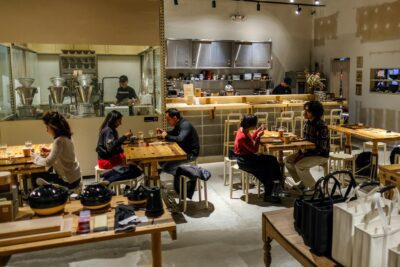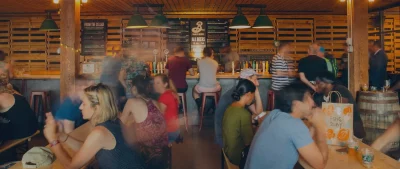Sake flight (Kato Sake Works)
Bringing sake down to earth—by way of Bushwick
Shinobu Kato’s flagship Brooklyn taproom demystifies Japan’s rice alcohol one craft pour at a time
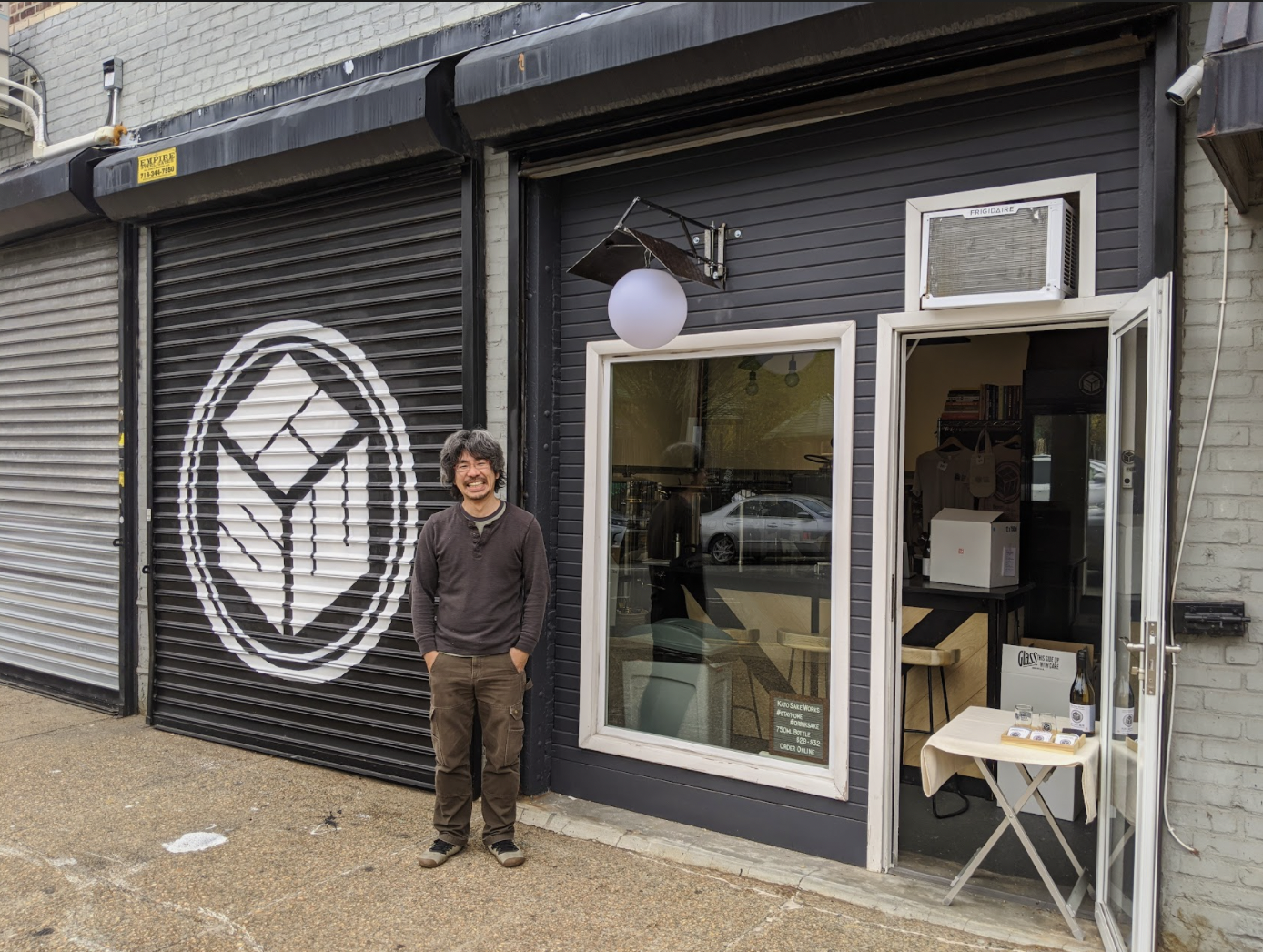
Shinobu Kato in front of the original Kato Sake Works location (Andrew Tobia)
Shinobu Kato is on a rice-spiked mission. “I can talk about sake for hours,” he says. “You don’t need to know about sake to enjoy sake. It won’t bite you.”
Short and energetic, with shaggy salt-and-pepper hair and a hair-trigger grin, Kato is a one-man sake drinker, brewer and evangelist. The founder of Kato Sake Works brewery, launched in the eye of the pandemic’s storm, Kato has weathered the worst that the past two years have thrown at him and is poised to move out of his cramped Bushwick taproom and into a much larger space later this year—and take his beverage of choice to an ever-expanding field of fanatics.
Kato Sake Works opened on Central Avenue in April 2020, an inauspicious time for entrepreneurs—the Covid-19 shelter-in-place order was just days old and there was little demand for a sake taproom in the heart of Brooklyn.
Which, to be fair, was the whole point in the first place: Kato likes to talk about the “democratization” of sake in America. In his native Japan, there are nearly 1,500 sake breweries. In the States, there are about 25. (One of them, Brooklyn Kura, opened in 2018 and is based in Sunset Park.) Sake, it turns out, has a bit of a PR problem. Kato, 48, is the self-appointed man for the job. Today, KSW has a full- and part-time staff of five and receives more wholesale orders than the space can physically handle. In fact, when he and I meet, production was maxed out, so Kato and his team are making a batch of chickpea miso to pass the time. Kato Sake Works’ original 500-square-foot space is just not cutting it anymore as a suitable sake shrine.
“I have a team now so we can do more, and that’s great,” Kato says. “We can produce more and stay open for longer. But we still have a ceiling, the size of the space. Here, we physically can’t make any more sake.”
This is why, by late this summer (“if everything stays on schedule”), Kato Sake Works will have a new flagship just down the street from their current one. At 2,500 square feet, it will be five times its current size and should allow Kato to expand his production tenfold.
Kato Sake Works—staffed up, selling fast and bursting at the seams—has come a long way since the early days of the pandemic. And now, in the aftermath of the Omicron wave, there is an element of déjà vu to Kato’s plight. “Maybe we shouldn’t do this,” he thought in 2020—and is no doubt thinking again now.
Maybe he shouldn’t. But that hasn’t stopped him yet.
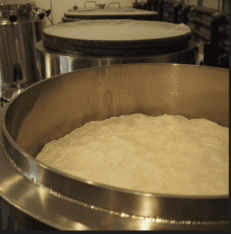

A batch of sake fermenting (courtesy Kato Sake Works)
A brief discussion of sake brewing
“The challenge in the U.S.—because sake has been hyped a little bit now—is it’s kind of intimidating and people feel pressure to have some basic knowledge before they can order,” Kato says. “But when I order beer or wine at a restaurant, I don’t feel that same kind of pressure. That’s the fight that I’m fighting. I want to make sake as casual as craft beer from the local brewery or a glass of wine.”
Although often compared to wine, sake actually bears more resemblance to beer in both its ingredients and how it’s made.
To make sake, a brewer sources heavily milled rice (milling removes the outer layers of the grain, which are mostly protein and fat, to expose the starchier centers), steams it, and inoculates it with Aspergillus oryzae, better known as koji. Koji is a fungus that does for sake what malt does for beer: produces enzymes to break a grain’s complex carbohydrates down to simple sugars, which yeast then eats during fermentation.
The fermented rice is then pressed, filtered (or not), pasteurized (again, or not), and bottled. Et voilà: sake! The process is essentially the same for beer, just trade rice for barley and koji for malting. The juice that wine is made from, on the other hand, naturally comes with simple sugars—it’s almost a set-it-and-forget-it process in comparison.
How Kato came to Bushwick
Shinobu Kato grew up in Keonji, a Tokyo neighborhood 10 minutes outside the city center, he says. “It’s residential with no big Walmarts or that kind of thing. It’s small-shop oriented, beer bars, thrift stores, music venues.It’s very similar to Bushwick. I feel very much comfortable here.”
He first encountered sake in college, where students drank it in much the same way that a typical American college student drinks beer: low quality in high quantity. He then graduated and entered Tokyo’s notoriously overworked salaryman corps.
“Maybe you heard that the Japanese businessman works from 9 to midnight every day, and that you go out drinking with your coworkers all the time,” Kato says. “I did that. And thanks to the seniority system, my boss always paid the bill.”
He describes this boss as a foodie and a sake connoisseur. “One day he said to me, ‘Shinobu, you don’t know anything about sake. You need to know good sake.’ So, he started taking me to fancy izakayas and basically educated me about sake,” says Kato. “My drinking philosophy became quantity and quality.”
After a time, seeking a change, Kato moved to Maryland to attend business school, where his classmates taught him about tailgating and keg stands, beer pong and “all that crazy shit.”
He moved to Nashville for a job at Nissan and was there for 10 years. There, Kato and his wife started having dinner parties. They would cook Japanese food but could never find good sake (at sensible prices, at least) to serve. During this time a lot of his friends had started brewing beer and, between that exposure to the brewing process and his constant search for good sake in America, Kato decided to brew some sake himself. The more he brewed, the more he improved, and the more his friends wanted to buy bottles from him.
Ultimately, Kato’s wife took a dream job offer in Tokyo and in her absence, he saw an opportunity. He quit his job at Nissan, relocated to Bushwick, and started laying the foundations for Kato Sake Works. (Romantics rest assured, his wife has since transferred to New York.) “He’s the only Japanese person in Brooklyn who makes sake,” says restaurateur and sake sommelier Toshi Koizumi, who owns Wasan restaurant in Park Slope and a-un, a sake bar in Bushwick where he serves Kato Sake Works sake.
“The concept for my restaurants is to support local,” says Koizumi, who was pleasantly surprised the first time he tried Kato Sake Works’ sakes. “It was great, much better than I expected. I was especially surprised by the Kimoto—it was the best sake I tasted that night. I’d love to see him expand and get more business, and to see him use different kinds of rice and koji.”
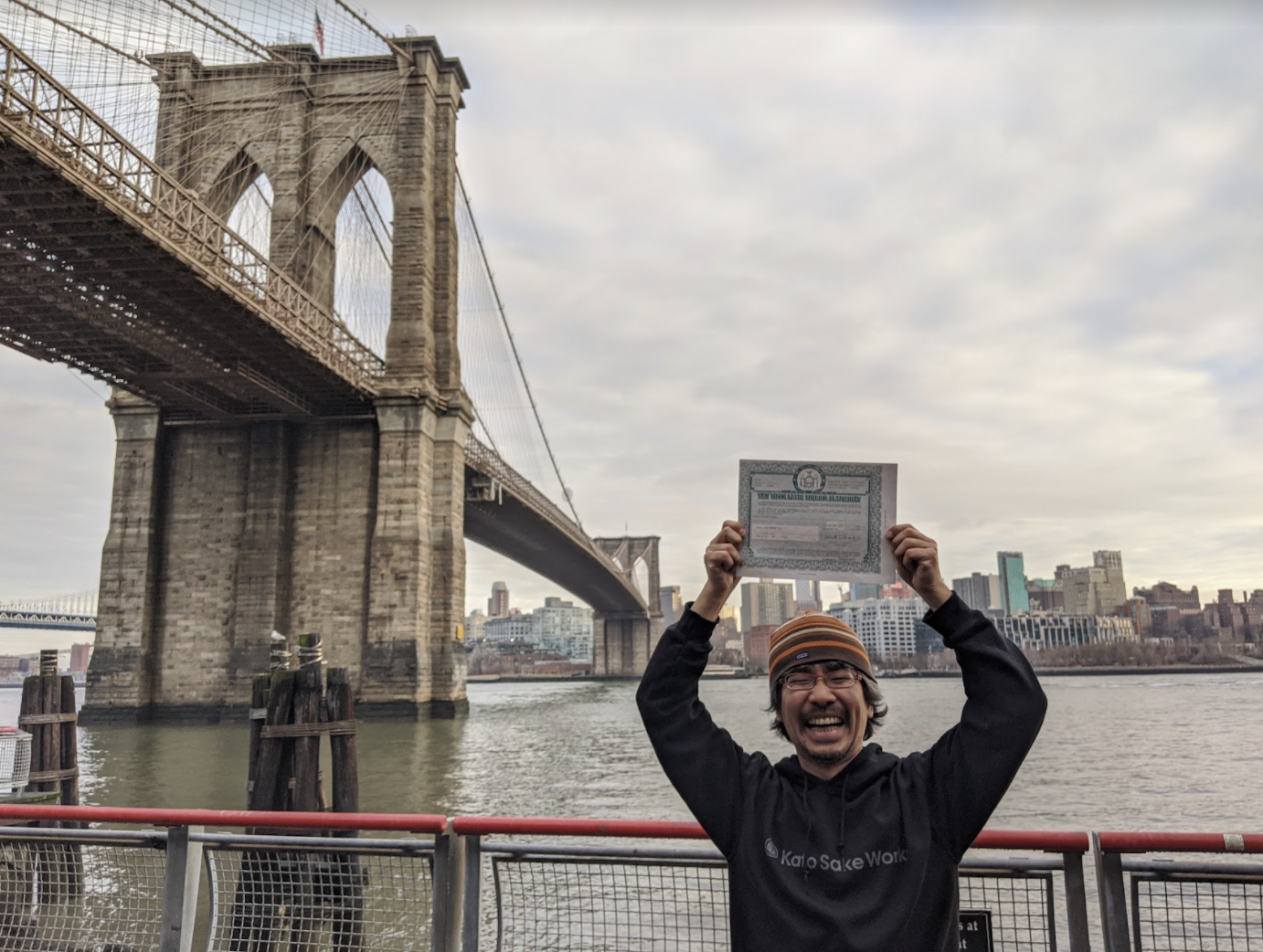

Kato with his alcohol manufacturing license at the foot of the Brooklyn Bridge (courtesy Kato Sake Works)
Grand opening: Quarantine
Kato Sake Works’ taproom was meant to be the centerpiece of the brewery. The idea was to lure unsuspecting sake virgins off the street, serve them a taste, and sell them bottles filled at the tap, the same way you can get a growler filled with craft beer.
But between the taproom’s soft-opening weekend and the planned grand opening, the city went into lockdown.
“Our space is too small; it’s too risky,” Kato remembers thinking. Instead of putting off the opening indefinitely, he decided to shift his entire business model and operational plan from a taproom focus to a bottling focus. Kato Sake Works offered its first pickup order on April 1 and, not long after, began shipping to all New York State addresses.
He pulled through on grit, creativity and, he says, the “strong local support from young Brooklynites who prefer to support local, small businesses.”
Kato Sake Works has partnered with other local businesses—namely Ridgewood Pork Store and Van Leeuwen ice cream—started fielding wholesale orders, began building
a team, and increased production.
Now, with 2022 upon him, Kato is ready for his big move to the new, larger facility and to finally welcome sake drinkers indoors to a proper tasting room. In the meantime, he launched a successful Mainvest campaign to help fund renovations at the new site. Because if the past two years have taught him anything, it’s to expect the unexpected.
“We’re borrowing a lot of money to do this expansion and I think, ‘What if we can’t pay it back and go bankrupt?’” Kato says. “But on the other hand I feel that once the expansion is complete, we’ll do great. And maybe we’ll need to expand again one day.”
Kanpai. We’ll drink to that.
This article first appeared in the winter/spring 2022 issue of Brooklyn Magazine. Click here to subscribe today.
You might also like 


















